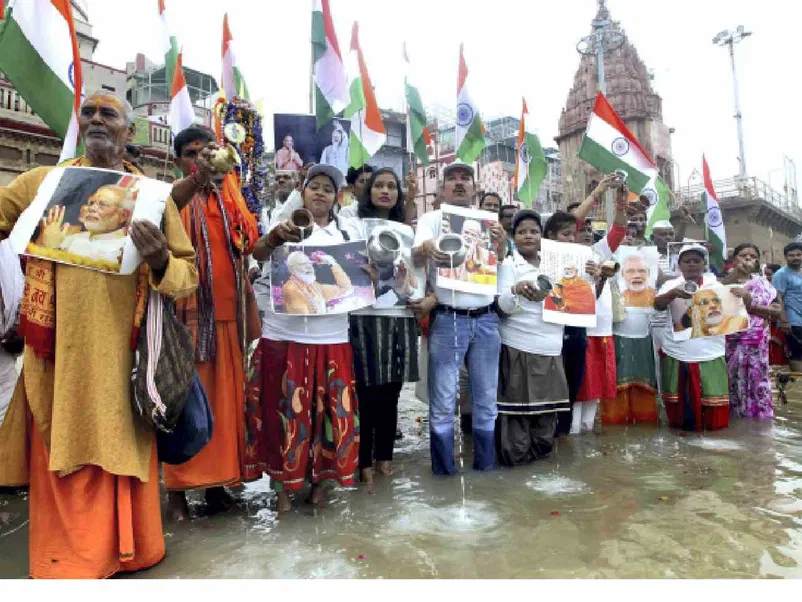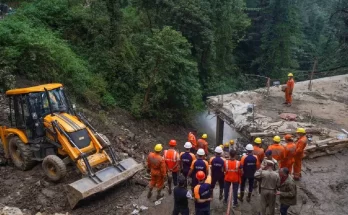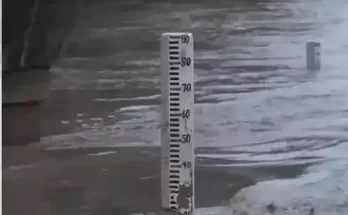Centre points at dolphins, turtles to claim water is pure, but experts say much work needs to be done.

Members of ‘Namami Gange Programme’ and residents hold photographs of PM Narendra Modi as they offer prayers at Dashashwamedh Ghat in Varanasi on Sept. 16, 2022. (Photo Credit: PTI)
Nine years after the launch of its flagship Namami Gange program, the Modi government seems to have forgotten the Prime Minister’s famous slogan: “Maa Ganga Ne Mujhe Bulaya Hai!”
Cleaning the Ganga does not appear anywhere on the list of achievements touted by the Centre over the past nine years. While the government claims that the increased presence of dolphins, turtles, and otters among other biodiversity is evidence of improved water quality, activists argue that the river is still far from being clean and flowing freely.
In 2014, the Modi government raised hopes of some conservationists when it renamed the Ministry of Water Resources to the Ministry of Water Resources, River Development, and Ganga Rejuvenation. Additionally, the “Namami Gange Program,” an integrated conservation mission, was approved as a flagship initiative in the same month, with a budget of Rs 20,000 crore. The program aimed to effectively reduce pollution and conserve and rejuvenate the highly polluted river.
Stretching over 2,500 kilometres from Uttarakhand to West Bengal, the Ganga passes through densely populated regions like Uttar Pradesh and Bihar, which are the major contributors to its pollution.
Pollution in the river arises from both point sources, such as domestic sewage and industrial effluents, and non-point sources, including agricultural runoff, solid waste dumping, open defecation, and religious waste. According to the Central Pollution Control Board (CPCB), domestic sewage contributes to 70% of the pollution load, industrial wastewater contributes to 20%, and the remaining 10% comes from non-point sources.
The Namami Gange Programme was launched in June 2014 with a budgetary outlay of Rs 20,000 crore, aiming to rejuvenate the Ganga and its tributaries until March 31, 2021. The program encompassed a comprehensive range of interventions, including wastewater treatment, solid waste management, riverfront development, afforestation, biodiversity conservation, and public participation.
However, by the end of 2022, the government realised that the work was far from complete. In February 2023, the Ministry for Jal Shakti stated that considering the need and scope of the project, the government had approved Namami Gange Mission-II with a budgetary outlay of Rs 22,500 crore until 2026. This included funding for existing liabilities and new projects.
As of April 2023, out of 186 projects aimed at creating sewage infrastructure, only 105 have been completed, with an expenditure of Rs 12,786.00 crore. The approved cost for developing a sewage treatment capacity of 4965.38 million litres per day (MLD) was Rs 29,809.67 crore, but only 1736.76 MLD capacity has been created.
G Ashok Kumar, Director General of NMCG, highlighted the increased sightings of dolphins, turtles, otters, and fishes as a testament to improved water quality in the Ganga.
From some 350 dolphins three years ago, he said, there are now 3,300 dolphins that are seen in the Uttar Pradesh and Bihar stretch of the main Ganga stem. “The juvenile numbers too are increasing as they are successfully breeding,” he said and added, “So is the case with turtles, otters and fishes. In fact, the number of Indian Major Carps (IMC) has increased as these species along with several native fishes prefer clean water.”
He made another claim regarding one of the NMCG’s mandates, which is to have water quality that is suitable for bathing. “But, up to Haridwar, Ganga water quality is better than bathing level quality,” he said.
However, Swami Shivanand of Matri Sadan in Haridwar – the same institution which achieved mainstream newsworthiness when one of its residents, Swami Sanand, undertook a fast unto death twice for the betterment of Ganga – pointed out that the water quality is still inadequate for bathing due to issues like high levels of Biological Oxygen Demand (BOD) and the presence of E. coli bacteria.
Ashok Kumar agreed with this view and added, “but all our new STPs have been built considering even the e-coli. Also, we have started collecting usage of chlorine utilization and collecting information sludge generation.”
NMCG had issued an order in October 2018 banning all mining activities in the Ganga river two days after Swami Sanand died. His successor, Swami Shivanand said, “It seems that it was due to pressure of Swami Sanand’s fast unto death that NMCG issued the order for banning mining. But in reality, even today, there is whole lot of stone crusher activity going on in and around Haridwar. We filed a writ petition for its implementation in the Uttarakhand High Court in 2022 and now we hear that the state government has announced to go to Supreme Court against it. It raises questions about NMCG’s authority.”
Pointing out that the NMCG order mentions, “illegal mining should be stopped,” Ashok Kumar said, “It is the states that have to stop it. Moreover, we have also formed committees with district administration to monitor it.”
One of the major achievements that the government highlights is the e-flow notification of 2018, which ensures a certain ecological flow in the river at any given time despites dams in its upper reaches.
But there are those who counter this claim. Himanshu Thakkar, of South Asia Network for Dams, River and People (SANDRP) said, “The government hasn’t taken any major step on this aspect except the 2018 e-flow notification. That, too, was not scientific, and it is not even implemented properly. The Central Water Commission was asked to prepare the monitoring report. It is not assessing it properly, so there is a failure in the manner in which water is released.”
An Environment and Social Audit Report of September 2022 of the NMCG pointed out several good practices, but it also said the site-specific Environment Management Plan (EMP) was not available as per the Environmental and Social Management Framework (ESMF).
It’s clear from an examination of the data that the Ganga is a long way from being pure. Of the total 6,000 (approximately) MLD sewage treatment capacity (along the Ganga main stem and tributaries) to be created, just 2200 MLD is available (as on April 2023); up from 991 MLD in December 2021. “Earlier, there were lot of procedural issues, we have slowly resolved them. Now the work will happen faster,” Ashok Kumar said.
Experts across the world point out that bigger rivers need a longer time frame to be cleaned up. For instance, the Thames took 60 years to go from ‘biologically dead’ to clean. Seine in Paris is another river that has seen massive efforts and funding, after which it was declared clean enough swim in. Potomac, Moskva, Vitasta and even Main, the longest tributary of the Rhine, are some rivers that took decades to clean up.
A.B. Pandya, Secretary General of the International Commission on Irrigation & Drainage (ICID), said: “China took 50 years just for discussion to improve its water management. Similarly, Murray Darling basin dealt with upstream wineries only after four to five decades. Thames river in London took more time than that. Another example is the Rhine river in Europe. The Rhine River Convention was signed in 1963 but ratified only in 1999. The whole cleaning took about 40-50 years. Tokyo river is another example. There was massive industrial development post the second world war. It took them 30-40 years’ time to clean it up.”
Of the Ganga, he said the main problem is that it traverses through densely populated cities and villages abutting the river bank. “Unlike the European cities, say for example, those on Rhine, which have a proper sewage system, the local bodies along the Ganga do not have or have less capacity and, definitely no money, to raise infrastructure and process the entire sewage. And hence, the NMCG is taking so much time in creating the treatment capacity – hardware and software,” he said.
Uttar Pradesh being the most populous state, contributes the highest sewage and industrial effluents to the flow of Ganga. It’s no surprise that all eyes are on the recent announcement by that state’s Chief Minister Yogi Adityanath, who said “the resolution (of his government) of ‘Aviral-Nirmal’ Ganga will be fulfilled ahead of Prayagraj Kumbh in 2025.”
(This story first appeared on news9live.com on Jun 01, 2023 and can be read here.)



